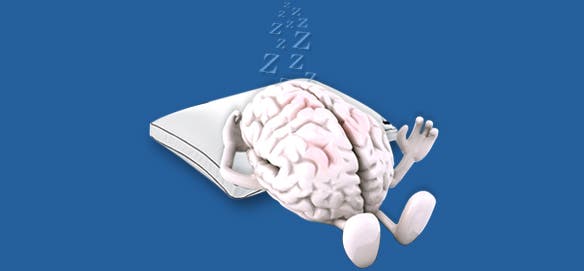
The brain’s reward system that motivates us to have sex, flee from predators, or search for food is deeply connected with the sleep-wake cycle through the same circuit. The researchers who identified the brain circuit and its relation to the two major systems for the first time say new drugs can be developed to specifically target this circuit. Insomniacs, for instance, could sleep soundly without suffering from the side effects of shutting down the whole brain.
The anatomy of sleep
Scientists have suspected for some time that there’s a connection between the reward system and the circuitry that governs sleep-wake states. After all, there isn’t anything to trigger a neurochemical feel-good reward in your sleep. The anatomical location of the interface between the brain’s reward and arousal systems has lacked until now, however.
Luis de Lecea and Ada Eban-Rothschild, both from Stanford’s Medical Center, used a bottom-up approach and went back to the roots — dopamine secretion. All vertebrates, be them fish, reptiles or mammals, have almost the same reward system in which the neurotransmitter dopamine plays a key role, regulating mood, sleep, movement, memory, learning, attention and more.
Most of the brain’s dopamine originates in secreting nerve fibers located in a particular brain structure called the ventral tegmental area (VTA). These dopamine-secreting fibers run in tracts to many different parts of the brain, supplying them with the pleasure-triggering chemical. Perhaps the greatest density of these fibers congregates in the nucleus accumbens, a forebrain structure involved in generating feelings of pleasure in anticipation of or in response to obtaining something.
“Since many reward-circuit-activating drugs such as amphetamines that work by stimulating dopamine secretion also keep users awake, it’s natural to ask if dopamine plays a key role in the sleep-wake cycle as well as in reward,” Eban-Rothschild said. “But, in part due to existing technical limitations, earlier experimental literature has unearthed little evidence for the connection and, in fact, has suggested that this circuit probably wasn’t so important.”
Sleepy, sleepy rodents
For their experimental setup, the researchers engineered lab mice so the animals’ dopamine-secreting cells in the VTA could be activated, suppressed or monitored remotely.
The activity of these nerve cells in the VTA rose sharply upon waking and stayed elevated throughout the time the rodents were awake. When the mice were about to go to sleep, dopamine secretion ramped down and remained low during slumber. When the team activated the nerve cells, the animals swiftly awoke from their sound sleep and stayed awake for long periods of time, even if it was way passed their bed time (the diurnal cycle).
When the VTA’s activity was suppressed during the rodents’ active part of their 24-hour-cycle, the mice dozed off the whole time despite the fact that temptations like high-fat food, a female, and fear triggering fox urine were laying about the cage.
Something very interesting happened when VTA-suppressed mice were put in a new and unfamiliar cage, though. You see, typically any mouse that is confined to a new environment will explore the surroundings energetically. The VTA-suppressed mice, which slumbered next to the most attractive and repelling stimuli imaginable for a rodent, stayed awake in this situation for the first 45 minutes of the hour they spent in the new cage. All of this waking time was spent building a nest — and “they were really careful about it”, Eban-Rothschild said.
Once the nest was finished to a satisfying degree, the rodents almost instantly fell asleep but if the VTA-suppressed mice were introduced in a new cage complete with the nest they just built, the rodents went soundly to sleep.
Control mice who received no intervention whatsoever ran around the new cage erratically and basically paid no attention to the pellet of nesting material.
This peculiar behavior was analyzed in great detail. Eban-Rothschild correlated 1-second-long video segments with the corresponding brain activity recorded during those frames. She saw that actions directly connected to building nests were marked by reduced VTA activity, while actions that weren’t were associated with higher levels of VTA activity.
“We knew stimulating the brain’s dopamine-related circuitry would increase goal-directed behaviors such as food- and sex-seeking” said Eban-Rothschild. “But the new study shows that at least one complex behavior is induced not by stimulating, but by inhibiting, this very circuit. Interestingly, this behavior — nest building — is essential to a mouse’s preparation for sleep.”
“This is the first finding of a sleep-preparation starter site in the brain. It’s likely we humans have one, too. If we’re disrupting this preparation by, say, reading email or playing videogames, which not only give off light but charge up our emotions and get our VTA dopaminergic circuitry going, it’s easy to see why we’re likely to have trouble falling asleep,” de Lecea added.
The researchers write in their paper published in the journal Nature Neuroscience that the sleep anticipatory phase is often the root of many people’s sleeping problems. Targeting this brain circuit might help insomniacs ease into sleep. Drugs that act on the VTA nerve cells could also help those suffering from schizophrenia or bipolar disorder that are also characterized by sleep-wake cycle disturbances.
“This has potential huge clinical relevance,” de Lecea said. “Insomnia, a multibillion-dollar market for pharmaceutical companies, has traditionally been treated with drugs such as benzodiazepines that nonspecifically shut down the entire brain. Now we see the possibility of developing therapies that, by narrowly targeting this newly identified circuit, could induce much higher-quality sleep.”
“We have plenty of drugs that counter dopamine,” he added. “Perhaps giving a person the right dose, at just the right time, of a drug with just the right pharmacokinetic properties so its effect will wear off at the right time would work a lot better than bombarding the brain with benzodiazepines, such as Valium, that knock out the entire brain.”
“It could be that merely solving the sleep-wake part will clear up a lot of symptoms,” de Lecea said.


